PMO Trends 2025
At the beginning of the year, the House of PMO launched its predictions for the PMO profession – PMO Trends for 2025 – and mid way through the year it seems like a good idea to see what has been happening within the PMO profession.
We took a look at the industry conferences, research reports, and expert analyses over the last six months – alongside our own activities here at the House of PMO, to see what the main areas of focus have been.
The standout areas have included the PMOs shifting from back-office support units to strategic enablers of value delivery; embracing Agile and hybrid approaches and technology and tooling advances.
Below is a digest of the most pertinent trends and highlights, organised by key themes and supported by recent UK and global insights.
PMOs Evolving into Strategic Business Partners
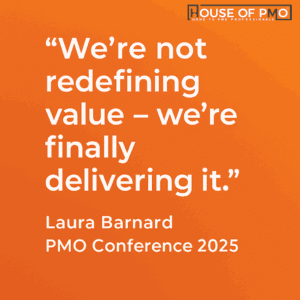 More and more PMOs are increasingly being positioned as strategic partners rather than administrative overhead. Many PMOs now align tightly with organisational strategy and even secure representation at the executive level [1] This marks a change from a few years ago, when PMOs were viewed primarily as process policemen or “project report factories.” Today’s PMO is expected to drive business value and strategy execution, not just monitor projects. Recent developments include:
More and more PMOs are increasingly being positioned as strategic partners rather than administrative overhead. Many PMOs now align tightly with organisational strategy and even secure representation at the executive level [1] This marks a change from a few years ago, when PMOs were viewed primarily as process policemen or “project report factories.” Today’s PMO is expected to drive business value and strategy execution, not just monitor projects. Recent developments include:
- Elevated Role & Influence: The majority of PMOs are considered strategic entities in their organisations, and the once-common skepticism of PMO value has sharply declined [1]. Notably, 73% of top-performing PMOs have a seat at the board level, shaping enterprise decisions, compared to about 47% of organizations overall [2]. This reflects growing trust in PMOs to guide strategic portfolios and ensure projects advance business goals. This evolution was underscored at the opening keynote of the PMO Conference 2025 [3], where industry leaders Eileen Roden, Laura Barnard, and Americo Pinto called for PMOs to move beyond delivery support and claim their place as strategic enablers. As Laura Barnard put it, “We’re not redefining value – we’re finally delivering it.” Their message was clear: the PMO of tomorrow isn’t optional – it’s integral.
- From Support Function to Strategic Unit: PMOs have transitioned from “project admin” units into strategy-aligned business functions. In the last decade, many PMOs moved from simply enforcing process to actively aligning projects with overarching corporate objectives [4]. Organisations are staffing senior PMO roles with people who have strong business acumen, ensuring the PMO speaks the language of executives and contributes to strategic planning.
- Value Office Mindset: Analyst firms recommend reimagining the PMO as a “Strategic Value Office (SVO)” to emphasize outcomes over bureaucracy [5]. Forrester, for example, suggests forward-looking enterprises rename and reshape PMOs into Enterprise Strategic Value Offices, with a mission to focus on value delivery, cross-silo transparency, and strategic agility. This involves orienting PMO services around internal/external customer needs and business outcomes, rather than just enforcing checklists. The goal is to break down silos and better connect strategy to delivery – a challenge many traditional PMOs struggled with.
- Industry Recognition: Developments in late 2024 set the stage for PMOs’ strategic importance in 2025. Notably, the Project Management Institute (PMI) acquired the PMO Global Alliance (a large PMO community) – a move widely seen as a signal of PMOs’ increasing strategic importance in organisations [6]. This incorporation of the global PMO community into PMI underscores the growing demand for PMO thought leadership, standards, and professional development at a strategic level.
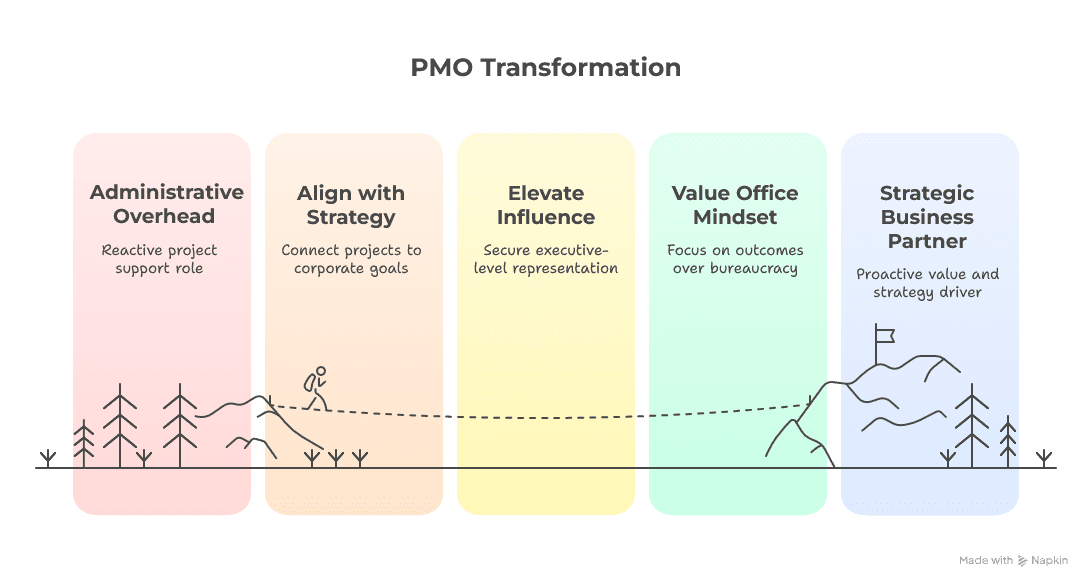
Delivering Value and Benefits, Not Just Projects
There is a clear trend toward value-driven PMOs. Instead of measuring success only by on-time, on-budget delivery, PMOs are being tasked with ensuring projects deliver real business value, benefits, and ROI. Key observations include:
- Outcome Focus: PMOs emphasise outcomes over outputs. This means ensuring that project results tangibly support strategic objectives and customer needs. High-performing PMOs make it a priority to communicate the benefits and strategic impact of initiatives, not just status reports [1] In fact, communicating progress on strategic outcomes (escalating risks, highlighting benefits, etc.) is listed among the top activities of leading PMOs [1]. This message was also delivered strongly at the PMO Conference 2025 [3] and is a key component of the Impact Engine authored and delivered by Laura Barnard.
- Value-Based Prioritisation: To maximize value delivery, PMOs are increasingly involved in portfolio prioritization based on strategic value and benefits. Rather than simply funding projects annually, organisations are moving towards continuous reprioritisation of initiatives based on value streams and changing needs [5] Forrester’s guidance highlights that many firms are attempting to shift from rigid project funding to more dynamic value-stream funding models – and PMOs (or newly dubbed value offices) facilitate this by focusing on high-value initiatives.
- Customer-Centric Mindset: Tied to the above is a push for PMOs to think in terms of customer value (whether internal or external customers). The PMO’s role in value delivery now often includes understanding end-user needs and ensuring projects enhance customer experience or stakeholder satisfaction [5]. This approach transforms the PMO into a bridge between strategy and execution, where delivering value to the customer becomes the north star for project selection and success criteria.
- Benefits Realisation Practices: Many organisations are strengthening their benefits realisation and value-tracking frameworks under the PMO. For example, it’s becoming common to require business cases with clear KPIs, to track benefits post-project, and for PMOs to report on value metrics (such as revenue impact, efficiency gains, user adoption) in addition to the classic time/cost/scope metrics. This ties in with PMOs being asked to “prove ROI” for projects on an ongoing basis, a demand that has grown louder in recent years [4] The net effect is a PMO that acts as a guardian of value delivery, ensuring the organisation gets the expected benefits from its project investments, or course-correcting when it doesn’t.
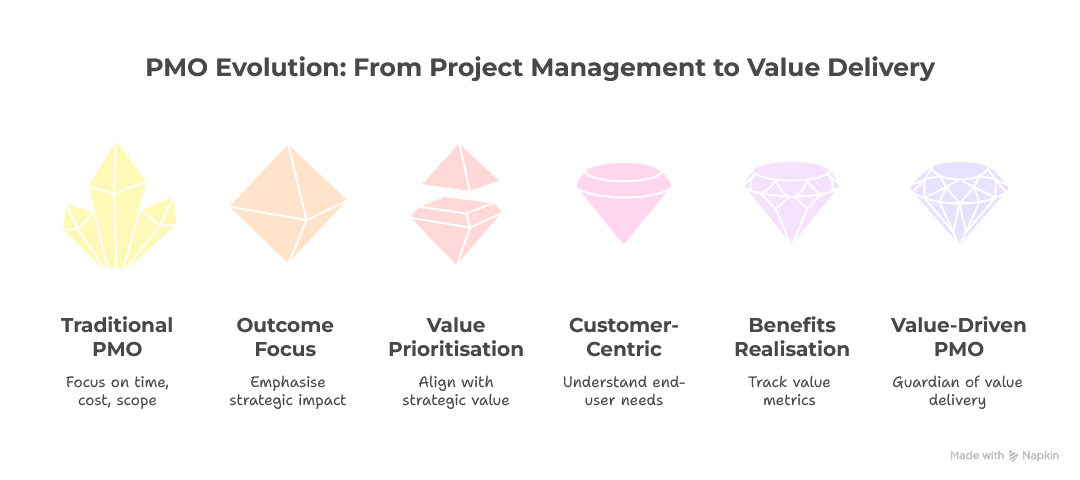
Embracing Agile and Hybrid Ways of Working
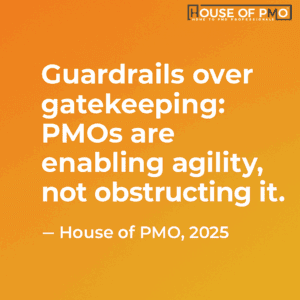 Another dominant theme is the PMO’s adaptation to Agile and hybrid project delivery models. Gone are the days when the PMO provided tailoring around predominantly waterfall based methodolgies. Over the past 6 months, insights show PMOs adopting more flexible frameworks to support a mix of methodologies:
Another dominant theme is the PMO’s adaptation to Agile and hybrid project delivery models. Gone are the days when the PMO provided tailoring around predominantly waterfall based methodolgies. Over the past 6 months, insights show PMOs adopting more flexible frameworks to support a mix of methodologies:
- Hybrid Delivery Models: 2024 and early 2025 have seen a widespread adoption of hybrid project methodologies. Organisations are blending Agile’s flexibility with traditional waterfall structure to suit diverse project needs. PMOs are expected to manage these hybrid environments by providing adaptable governance that can oversee Scrum teams and phase-gate projects side by side. The emphasis is on “guardrails over strict controls,” allowing teams to deliver in the way that fits their work while the PMO ensures alignment and quality. This hybrid approach is becoming the norm, with predictions that by 2025 most PMOs will be proficient in juggling both Agile and traditional projects within a unified portfolio.[6][8]
- Agile PMO Mindset: The concept of an “Agile PMO” has matured from buzzword to reality. Trend analyses note that discussions about Agile in the PMO started around 2016, and by now, many PMOs actively support Agile-at-scale, DevOps practices, and iterative delivery alongside conventional projects [4] In practice, this means PMOs might provide Agile coaches, help teams choose the right approach per project, or maintain enterprise Kanban boards and OKR tracking. By 2024, the call was for PMOs to enable seamless integration of diverse delivery frameworks – essentially making methodology agility a core competency of the PMO.[8]
- Continuous Improvement & Adaptability: With Agile principles in play, PMOs are also championing a culture of continuous improvement. They encourage retrospectives not just at the team level but for the project delivery system as a whole, continuously refining governance processes. According to one 2025 trend report, PMOs must foster a culture of adaptability and learning, reflecting on what works in Agile or hybrid execution and evolving accordingly [4] In many organizations, PMOs are now the ones training teams on new ways of working and driving organisational agility initiatives (often hand-in-hand with change management efforts).[7]
- Challenges in Agile Environments: Of course, this shift is not without challenges. PMOs have been challenged to prove their value in Agile-driven environments [4], dispelling the notion that “Agile makes PMOs obsolete.” The best PMOs have responded by repositioning themselves from gatekeepers to facilitators – for instance, simplifying processes for Agile teams, focusing on high-level outcomes rather than detailed task tracking, and ensuring even autonomous squads remain aligned with strategic objectives. This balance of autonomy and oversight is still evolving, but it’s clear that agility is now a core part of the PMO’s mandate.[7]
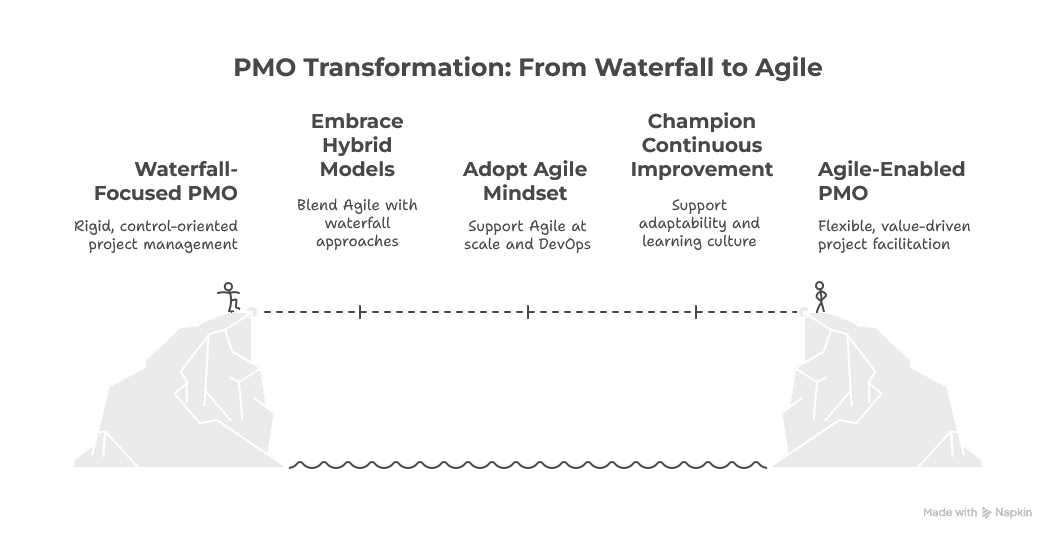
Technology and Tooling Advancements in the PMO
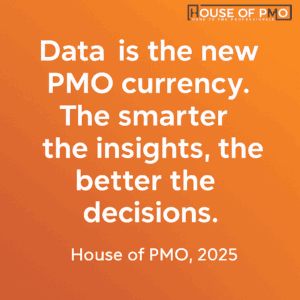 Technology is a critical enabler of the PMO, and the past half-year saw rapid advancements in how PMOs leverage tools, especially data analytics and AI, to enhance decision-making and efficiency. Several notable developments include:
Technology is a critical enabler of the PMO, and the past half-year saw rapid advancements in how PMOs leverage tools, especially data analytics and AI, to enhance decision-making and efficiency. Several notable developments include:
- Data-Driven PMOs: PMOs are investing in data analytics capabilities to become data-driven organisations. This trend, which began with basic project dashboards a few years ago, has accelerated with the integration of advanced analytics. Some PMOs now employ data analysts or equip their teams with business intelligence tools to mine project data for insights [4]. By 2024, leading PMOs were leveraging advanced analytics and even AI (e.g. machine learning, ChatGPT) to enhance reporting and support better strategic decisions. Access to real-time, quality data has enabled PMOs to provide predictive insights (like flagging at-risk projects) and to back up recommendations to executives with hard data. This trend has certainly been seen at the House of PMO, with many different case studies presented at the PMO Conference over the last few years and is set to continue in the months and years ahead.
- AI and Automation: The buzz around AI has started translating into practical PMO tools. While few PMOs claim “transformative” AI integration yet, many are experimenting with AI-driven features in Project Portfolio Management (PPM) software. Gartner’s 2025 trends report explicitly advises PMO leaders to “leverage the power of AI to optimize execution and decision-making” [10]. Concretely, this means using AI for things like predictive analytics, risk modeling, automated status report generation (via chatbots or auto-filled project updates), and even AI assistants that can answer project queries. Early adopters report that predictive analytics help foresee issues and reduce risk exposure, while AI-driven tools can streamline reporting and automate routine tasks, freeing PMO staff for higher-value work. For example, some organisations have deployed AI to scan project metrics and alert the PMO of anomalies, or to automatically update project schedules based on team inputs, functionalities that improve speed and accuracy of portfolio oversight.
- Streamlined Tool Ecosystems: The proliferation of tools (task trackers, collaboration apps, PPM platforms) has been a double-edged sword. A key trend now is consolidating and integrating the PMO’s toolset. Gartner suggests simplifying the tech ecosystem to reduce cost and complexity while minimizing data silos [12]. Many PMOs are moving toward integrated platforms that combine project management, resource management, and portfolio analytics in one, or ensuring their Agile tools (like JIRA/Azure DevOps) sync smoothly with portfolio dashboards. The goal is a single source of truth for project data. In fact, a recent survey noted that on average only ~50% of PPM software capabilities are utilised by organisations – indicating room to better exploit existing tools [6]. The push in 2025 is to fully leverage these tools (or new ones) so that reporting and governance become more automated and real-time.
- AI in PMO Governance: Recognising the rise of AI, PMI itself launched “PMI Infinity” in early 2024 – an AI-powered knowledge and support tool for project professionals. This underscores how project management bodies see AI as integral to the future of the field. PMO-specific use of AI also raises new considerations: PMOs are beginning to establish governance around AI usage (ensuring data quality, addressing biases in AI recommendations, etc.). There’s acknowledgment that while AI can handle administrative and analytical tasks, it cannot replace human leadership qualities like empathy, vision, and ethical judgment [4]. Thus, the PMO of the near future is envisioned as tech-augmented but still human-centered, using sophisticated tools to amplify human decision-making, not to override it.
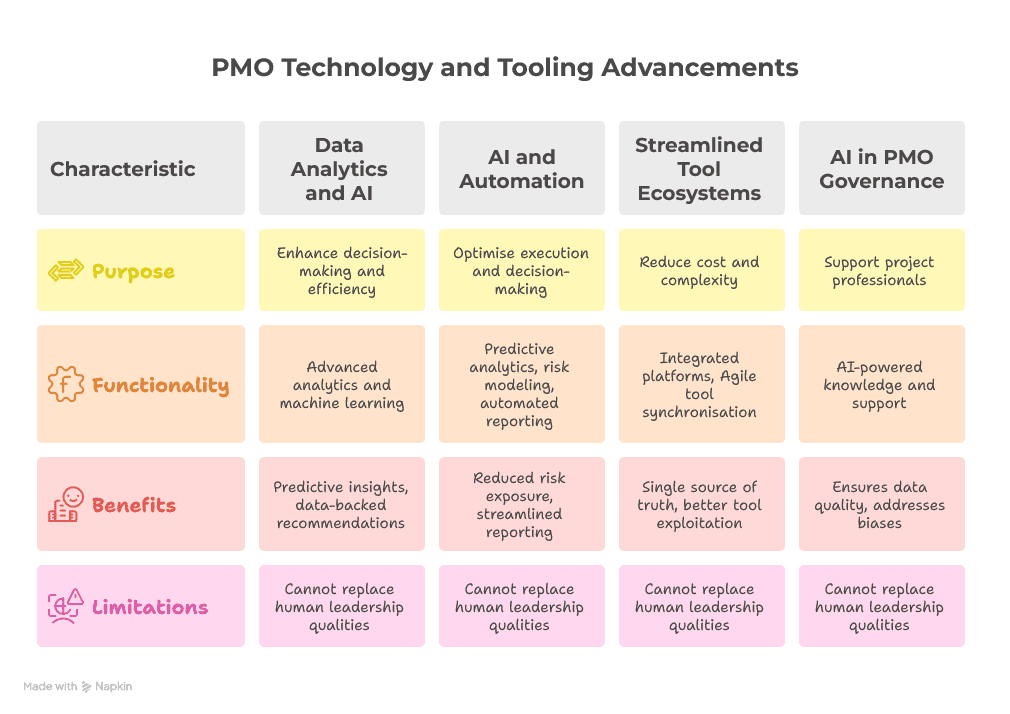
The PMO Conference 2025 in London marked the 10th anniversary of our conference, underscoring the community’s focus on strategic, value-driven and technology-enabled PMOs. The conference (June 2025) featured dedicated streams on PMO leadership & strategy, technology & AI, and future ways of working, reflecting the profession’s current priorities [11]. Keynotes and panels highlighted how far PMOs have evolved in the past decade and where they are headed next. Become a member at the House of PMO to access these and other PMO focused resources.
Industry Highlights, PMO Trends and Events (Late 2024 – Mid 2025)
Several conferences, publications, and research releases in the last six months have captured these trends and provided guidance to PMO practitioners:
- House of PMO – PMO Conference 2025 (London): This annual UK conference (held in June) celebrated its tenth year and reinforced the strategic and innovative direction of PMOs. Sessions covered topics like PMO as a business-led function, AI and data analytics in PMO, real-world case studies on portfolio value delivery, and the future skillsets needed in PMOs. The opening keynote, featuring PMO thought leaders Eileen Roden, Laura Barnard, and Americo Pinto, reflected on the PMO’s evolution over the past 10 years and key shifts in strategy, technology, and leadership that PMOs must embrace going forward. The very inclusion of a full track on “Technology, Data & AI in PMO” speaks to how digital tools and data-driven practices are now front and centre for PMOs.[11]
- PMI’s Pulse of the Profession 2025: PMI’s latest Pulse report (March 2025) focused on “Boosting Business Acumen” – effectively calling on project professionals (including PMO leaders) to develop stronger business savvy to become strategic value creators. While not solely about PMOs, this reflects a broader industry expectation that PMOs should contribute to business strategy. It reinforces the idea that PMO staff need to understand finance, strategy, and the language of the C-suite in order to elevate project outcomes beyond the iron triangle of scope, schedule, cost. The PMI report’s emphasis on business acumen aligns with the strategic partner trend noted above, underlining that PMOs must cultivate these skills to stay relevant.
- Gartner’s Top PPM Trends 2025: Gartner released a report in May 2025 identifying top trends for program and portfolio management leaders. Key takeaways mirror what we’re seeing on the ground: PMO leaders are under pressure to cut costs and deliver value faster, the PMO role is shifting “from compliance enforcer to strategic enabler,” and there are strategic imperatives to adopt new tech and more adaptive portfolio practices. Gartner specifically advises PMOs to streamline their toolsets, embrace AI for project execution, increase the frequency of portfolio reprioritisation (for agility), and redefine PMO roles to focus on agility and business value. This authoritative insight validates the trends of tech-enabled agility and strategic value focus in PMOs.[10]
- PM Solutions “State of the PMO 2025” Research: In May 2025, PM Solutions (a US-based consultancy) published its biennial State of the PMO report, offering data-backed insights. One highlighted finding is that PMOs have truly become “strategic powerhouses” of project execution in many organisations [1]. High-performing PMOs in the study shared common characteristics: they facilitate enterprise-wide knowledge sharing, enforce consistent governance standards, communicate progress on strategic objectives, and ensure work is aligned to goals. The research also noted that PMO budgets have remained stable even as their strategic contributions have grown, indicating improved efficiency and value for cost. For PMO leaders, this report serves as both a benchmark and a playbook, confirming that investing in areas like resource sharing, templates, benefits tracking, and strategic alignment yields measurable improvements in project outcomes.
- Forrester’s Guidance – The Future-Fit PMO: Industry analysts at Forrester have been advocating for radical changes to the traditional PMO model. In a late-2024/early-2025 briefing, Forrester’s experts suggested that to be “future-fit,” organizations should rebrand and reshape PMOs into Strategic Value Offices that prioritise adaptability and value delivery. They observe that many PMOs struggle with siloed business vs. IT priorities and outdated annual planning cycles, which can hinder connecting strategy to execution. By adopting an SVO model, firms aim to solve these issues: enabling continuous planning, focusing on end-to-end value streams, and putting customer value at the center of portfolio decisions. This thought leadership has been influential, with some companies already adopting the SVO terminology or similar reforms to ensure their PMO is seen as a driver of strategic change rather than a bureaucratic hurdle.[5]
- House of PMO – 2025 Portfolio Management Whitepaper: Published following a roundtable in March 2025, this whitepaper captures real-world portfolio management insights from PMO leaders across sectors. It highlights themes such as resource-first planning, governance brokering, and portfolio rationalisation, with a strong push for practical knowledge sharing over traditional “lessons learned” documentation. The paper reinforces the PMO’s evolving role – from enforcer to enabler – and offers actionable recommendations for aligning delivery with strategic outcomes in today’s resource-constrained and fast-moving environments. [13]
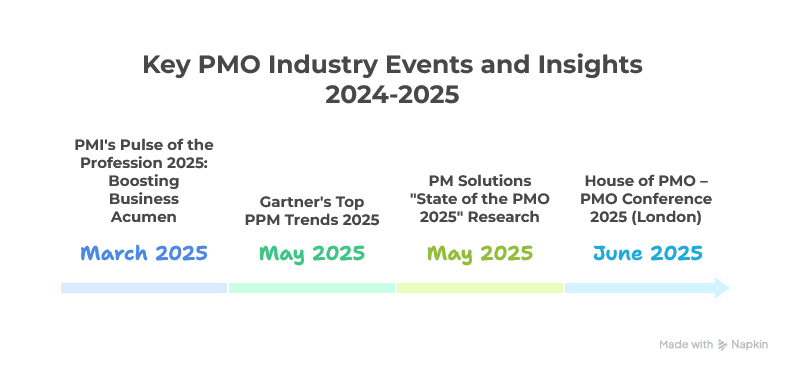
Over the last six months, it’s becoming crystal clear that PMOs are on a serious transformation journey, shifting from process-heavy support roles to becoming strategy-driven, value-focused change enablers. The signals are everywhere, from global conferences to industry reports: PMOs are expected to lead with insight, flex with hybrid delivery, and make smart use of tools like AI. The PMOs that will thrive in 2025 and beyond aren’t just tracking progress, they’re actively driving it, becoming essential partners in delivering real business impact.
Sources: Major PMO conferences and reports from Jan to Jul 2025, including House of PMO insights, PMI publications, Gartner research, PM Solutions’ State of the PMO 2025, and Forrester analysis on future-fit PMOs. These collectively capture the latest trends shaping PMOs in the UK and worldwide.
[1] How the State of the PMO 2025 Research Is Guiding the C-Suite
[2] PMI Germany Chapter e.V. – PMI welcomes PMOGA
[3] The Past, Present and Future of PMO / 2025 PMO Conference Opening Keynote
[4] Being the glue will not cut anymore
[5] To Become Future Fit, Ditch The PMO Moniker
[6] Top Five PMO Trends for 2025
[7] The New Role of the PMO in Agile: Facilitating, Supporting, and Innovating
[8] The Top 5 PMO Trends to Prioritize in 2025
[9] Top 7 Project Management Trends: How Your PMO Can Lead in 2025
[10] Gartner® Report – Top Trends for Program and Portfolio Management Leaders for 2025
[11] PMO Conference 2025 / Celebrating Ten Years | House of PMO
[12] Pulse of the Profession® Report 2025 | PMI
[13] Strategic Portfolio Management: Connecting Strategy to Delivery Through the PMO
The images used throughout the article have been created using Napkin, check it out as a really useful PMO tool!








